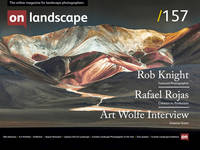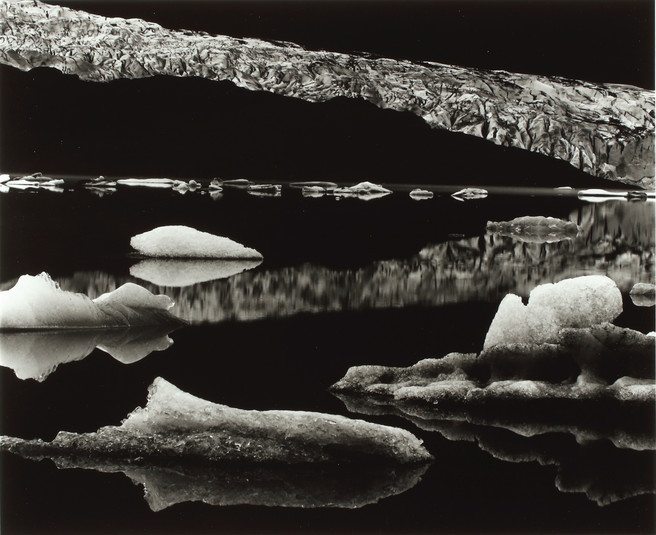Rupert Nicholson chooses one of his favourite images

Rupert Nicholson
I graduated in Photography in 1980 from Art college. I have 30 years of Forensic Photography experience at Major Crime Scenes. I have been taking Landscape Photographs for the last five years. Although most of my work is shot on digital, I have set up a dark room and been printing from medium and large format negatives. Twitter Flickr
Delighted to be asked to share my favourite image – well one of them anyway!
I have chosen Mendenhall Glacier, photographed by Brett Weston – b.1911 – d.1993 (whose Father was the more famous Edward Weston)
This image was photographed in 1973, and the location is in coastal, South East Alaska. The glacier is 13.6 miles long and has retreated 1.75 miles since 1929.
In 1925 Brett was taken out of school at the age of 13 and travelled with his father, from Carmel, California to Mexico, where the young Weston began to learn his trade and Art, and Brett became his father's apprentice. He was surrounded by revolutionary artists of the day including Tina Modotti, Frida Kalo and Diego Rivera.
It has been said that his introduction to Modern Art through the work of painters Rivera and Jose Clemente Orozco, greatly influenced his sense of form and composition. Van Deren Coke described him as the “child genius of American Photography”
At 17 his work was being exhibited internationally, and he exhibited a group of images in the German exhibition “Film and Foto”.
He had his first one-man exhibition in San Francisco at the age of 21. His first camera was a Graflex 3,1/4 x 4,1/4 inch, and he later used 10x8 and 14x11inch view cameras. In his latter years, physical difficulties made him choose medium format Rollei SL6x6 and Mamiya RB6X7. Over many decades he travelled extensively through the Western states of New Mexico, California, Oregon and Alaska; Also Mexico, Europe and Asia, away from his native California.
In 1945 he was awarded Guggenheim Fellowship for creative Arts, USA and Canada.
The Mendenhall Glacier image was printed by the artist onto Silver Gelatin, Glossy paper and is retailing currently, upwards of 20,000 USD for a 20X16 Inch print, and around 10,000 USD for a print size 7,5/8 x 8,7/8 inches. Incidentally, the young Edward Weston persuaded his established father to change printing his work on Platinum papers and use Silver Halide Glossy papers, with richer tones. Edward Weston acknowledged that he was influenced by his son Brett with his own Photography.
This image would have been photographed on a large plate view camera (probably a 10x8 inch format) and most likely would not have been cropped as was the ethos of the f64 group of “Modernist” photographers, who Brett Weston was invited to exhibit alongside with the original core of f64 Photographers.
It would appear that this photograph was exposed on a bright sunny, cloudless day, with no wind, leaving the glacial water like a mirror.
The composition is typically abstract, with strong bold shapes of Black tones from the land mass in front of the glacier, the foreground water, and the sky. I think a Red filter may well have been utilised to enhance these very dark and rich tones.
Contrasting with the strong shapes of dark tone is the light toned glacier to the top of the picture and smaller pieces of broken/thawed glacier blocks in the foreground.
The image area has a similar amount of “Positive” and “Negative” shapes (Undetailed Blacks versus Light tones of glistening Ice) The Style of Brett Weston’s compositions often gave the viewer a flat depth two-dimensional appearance as opposed to a three-dimensional appearance, aiding his abstract trademark.
We all perceive other photographer’s images with our own interpretation, and for myself, this image is not easily viewed. I find that I look at the bold Black land mass and the glacier as one point of interest, and then look at the foreground broken ice pieces in a Sea of darkness. It is like looking at two images within one frame. However, I can return to the image and view it as a complete diagonal, zig-zag compositional flow.
I remember the first time I viewed this picture, in 1978, when I bought the book “Voyage of the Eye” for £6.00.(Brett Weston has said there are much better quality books of his work) I remember looking at it and wondering what is it? Only when I viewed the title, did I connect with the composition content! This was long before we all visited Jokulsarlon Glacier Lagoon. Glacial landscape familiarisation for this young Photography student was not the case, especially since I didn’t practice Landscape work until decades later.
I still enjoy this image now, as much as I did in 1978. I like pictures that need scrutinising and searching, pictures that are strong in shape and form, pictures that I can see differently each time I view them. The abstract aesthetics hold my attention, and there is no ambiguity in the content of this picture. My enjoyment and appreciation for Monochrome landscapes and this image belongs to the knowledge that we do not view in Monochrome, and as such, in my opinion, there is greater scope than Colour for artistic interpretation, expression and representation.
monovisions.com is a good source for viewing Brett Weston’s close up abstract imagery of subjects including Plant leaves, knotted roots and tangled kelp.


